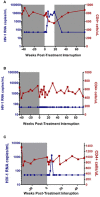Learning From the Exceptions: HIV Remission in Post-treatment Controllers
- PMID: 31396237
- PMCID: PMC6668499
- DOI: 10.3389/fimmu.2019.01749
Learning From the Exceptions: HIV Remission in Post-treatment Controllers
Abstract
Among the top priorities of the HIV field is the search for therapeutic interventions that can lead to sustained antiretroviral therapy (ART)-free HIV remission. Although the majority of HIV-infected persons will experience rapid viral rebound after ART interruption, there are rare individuals, termed post-treatment controllers (PTCs), who demonstrate sustained virologic suppression for months or years after treatment cessation. These individuals are considered an ideal example of durable HIV control, with direct implications for HIV cure research. However, understanding of the mechanisms behind the capacity of PTCs to control HIV remains incomplete. This is in part due to the scarcity of PTCs identified through any one research center or clinical trial, and in part because of the limited scope of studies that have been performed in these remarkable individuals. In this review, we summarize the results of both clinical and basic research studies of PTCs to date, explore key differences between PTCs and HIV spontaneous controllers, examine potential mechanisms of post-treatment control, and discuss unanswered questions and future research directions in this field.
Keywords: HIV; elite controllers; post-treatment controllers; remission; treatment interruption.
Figures


Similar articles
-
Virologic and Immunologic Features of Simian Immunodeficiency Virus Control Post-ART Interruption in Rhesus Macaques.J Virol. 2020 Jul 1;94(14):e00338-20. doi: 10.1128/JVI.00338-20. Print 2020 Jul 1. J Virol. 2020. PMID: 32350073 Free PMC article.
-
Posttreatment controllers: what do they tell us?Curr Opin HIV AIDS. 2015 Jan;10(1):29-34. doi: 10.1097/COH.0000000000000123. Curr Opin HIV AIDS. 2015. PMID: 25402707 Review.
-
How elite controllers and posttreatment controllers inform our search for an HIV-1 cure.J Clin Invest. 2021 Jun 1;131(11):e149414. doi: 10.1172/JCI149414. J Clin Invest. 2021. PMID: 34060478 Free PMC article. Review.
-
Immunovirologic control 24 months after interruption of antiretroviral therapy initiated close to HIV seroconversion.Arch Intern Med. 2012 Sep 10;172(16):1252-5. doi: 10.1001/archinternmed.2012.2719. Arch Intern Med. 2012. PMID: 22826124
-
HIV controllers: hope for a functional cure.Front Immunol. 2025 Feb 25;16:1540932. doi: 10.3389/fimmu.2025.1540932. eCollection 2025. Front Immunol. 2025. PMID: 40070826 Free PMC article. Review.
Cited by
-
Expression of type I interferon-associated genes at antiretroviral therapy interruption predicts HIV virological rebound.Sci Rep. 2022 Jan 10;12(1):462. doi: 10.1038/s41598-021-04212-9. Sci Rep. 2022. PMID: 35013427 Free PMC article. Clinical Trial.
-
Early Viral Dynamics Predict Human Immunodeficiency Virus Posttreatment Control After Analytic Treatment Interruption.J Infect Dis. 2025 Feb 20;231(2):e419-e428. doi: 10.1093/infdis/jiae551. J Infect Dis. 2025. PMID: 39513745 Free PMC article.
-
Dynamics and origin of rebound viremia in SHIV-infected infant macaques following interruption of long-term ART.JCI Insight. 2021 Dec 8;6(23):e152526. doi: 10.1172/jci.insight.152526. JCI Insight. 2021. PMID: 34699383 Free PMC article.
-
Virologic and Immunologic Features of Simian Immunodeficiency Virus Control Post-ART Interruption in Rhesus Macaques.J Virol. 2020 Jul 1;94(14):e00338-20. doi: 10.1128/JVI.00338-20. Print 2020 Jul 1. J Virol. 2020. PMID: 32350073 Free PMC article.
-
Reduce and Control: A Combinatorial Strategy for Achieving Sustained HIV Remissions in the Absence of Antiretroviral Therapy.Viruses. 2020 Feb 8;12(2):188. doi: 10.3390/v12020188. Viruses. 2020. PMID: 32046251 Free PMC article. Review.
References
-
- Exceptional Responders Initiative: Questions and Answers. National Cancer Institute. (2018) Available online at: http://www.cancer.gov/about-cancer/treatment/research/exceptional-respon...
Publication types
MeSH terms
Substances
LinkOut - more resources
Full Text Sources
Medical

